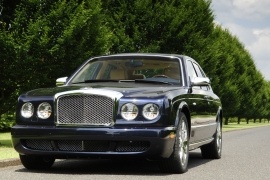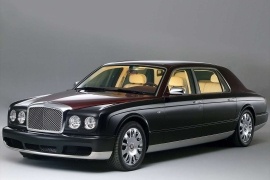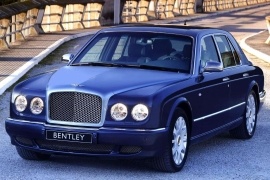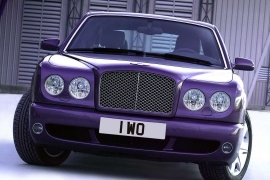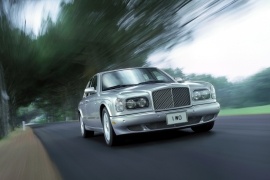BENTLEY Arnage Models/Series Timeline, Specifications & Photos
First production year: 1999
Engines: Gasoline
The Arnage was the last Bentley designed before the Volkswagen takeover of the British brand. After a dispute with BMW regarding the engines, the new owner revised Bentley's flagship model for better performances.
The Arnage Blue Train was a 75 years anniversary of a bet. In 1930, Woolf Barnato, a three-times winner at the famous LeMans race in France, placed a GBP 200 bed that he could get faster from Calais to London with a Bentley bodied by H.J. Mulliner Sportsman Coupe fastback than someone who would use the train. After the bet was set, Barnato raced and won.
75 years later, the Arnage Blue train special series was launched into a limited, 30 units, model. The car featured "Blue Train" badges on the front wings. A specific plate with a limited number series was installed inside the car. The special series featured 19" seven-spoke light-alloy wheels, sunroof, chromed grille and mirror caps, and four exhaust pipes. The front and rear bumpers were redesigned for the special series.
The car was based on the Arnage R-Model with the 6.75 V8 engine, instead of the 4.4-liter V8 from BMW since the German engine was mated to a gearbox that couldn't handle too much torque. The old 6.75 unit offered 450 hp and 875 Nm (645 lb-ft) of torque and it was mated to a GM-supplied 4-speed automatic gearbox.
The 2005 Bentley Arnage was the last Bentley that could have been linked with the Rolls-Royce and with the 6.75-liter engine that was designed in the '50s.
The Bentley and Rolls-Royce marriage ended when Volkswagen bought the former and BMW bought the latter. Actually, BMW bought only the name, the statue, and the grille. Volkswagen was not prepared to launch a new car, but it still had to make its mark in the British company. So, in 2005, it introduced the Arnage.
It was easy to recognize the same lines from the Arnage and Rolls-Royce Silver Seraph. Both vehicles had the same classy shape of a three-box sedan with rounded fenders as they were designed in the '60s. The twin headlights of the Arnage were old fashion but still looked proper in the car. The grille was different. A mesh-grille resembled the grilles used in former Bentley race cars.
Inside, there was a typical Bentley with leather, metal and wood. There were some plastic parts and bits here and there, but nothing important. The flat armchairs for the front passengers were large enough to offer comfort. They were not bolstered enough to keep its occupants safe in place while hard cornering. In the rear, there was room for two adults. The middle seat was more of a connecting bridge between the outer two seats.
Under the hood. VW installed the old 6.75-liter engine but aided by a pair of turbochargers. The transmission was still the 4-speed automatic. But, since the power and torque were huge, it didn't need any more gears in the box.
The Arnage R was the short-lived Bentley that fell victim in the war between BMW and Volkswagen. But it remained a masterpiece in British brand history.
At the beginning of the '90s, Vickers Plc was the owner of Rolls-Royce and Bentley brands. It decided to refresh the old models and looked for new engines and BMW was selected. The design for both models was made in-house and the result was Rolls-Royce Silver Seraph and Bentley Arnage. While the first received a naturally aspirated 6.75-liter V12 engine, the latter got a 4.4-liter V8 upgraded by Cosworth Engineering with a pair of turbochargers.
From the outside, the Arnage looked modern when compared with its predecessor. It was sleeker, had a better aerodynamic, and its fuel-efficiency was improved. The dual headlights covered with a clear-lens was a first for Bentley. The Arnage R featured a mesh-grille, in the spirit of its former racing glory. The swept-back beltline was similar to the Seraph.
Inside, the Arnage R featured a luxurious interior with leather, wood, and aluminum. In its pure tradition, the instrument panel was flat with silver circles around the gauges. The atmosphere resembled a British gentlemen club. In the back, there was enough room for two occupants, but due to the thick front seats, the legroom was limited for tall passengers.
When the battle between BMW and Volkswagen started to get the Rolls-Royce brand, the Bavarian threatened to stop delivering the engines. Then, Volkswagen took away the 4.4-liter unit and installed the older V8 in the Arnage. But for a while, the Bentley Arnage was powered by a BMW engine and that was the Arnage R.
Bentley brought back the old 6.75-liter V8 engine developed in the late '50s, added a pair of turbochargers on it, and launched the Arnage T on the market in 2002 at the North American International Auto Show.
After Volkswagen bought the Bentley brand, BMW purchased Rolls-Royce, and friction appeared between the two German automakers. But the latter automaker provided the engines for both marques. That forced the former to retrieve the old Bentley V8 powerplant from the parts bin, refresh it with new electronics and Garett turbochargers, and install it in the Arnage. Thus, the majestic luxobarge managed to smoke its tires and do donuts. But on the other hand, it remained an elegant vehicle.
Its exterior appearance didn't hint what it could actually do. Still, its mesh grille at the front and the air intake from its dam were clues about the car's bipolar character. Furthermore, the light-alloy wheels were different than on the regular Arnage. Finally, at the back, there was no lip spoiler on the trunk nor a diffuser underneath the bumper. Yet, it sported oval side exhausts with chromed tips.
Inside, it was Bentley as usual. A true British lounge with wood trims on the dash, center console, and doors. Its front bucket seats provided little to no side support for their occupants, and the benchseat in the back was suitable for transporting two adults in comfort.
But underneath the bodywork stood a true beast. Its massive 738 lb-ft (1000 Nm) of torque could shred the rear tires at any moment. Power went to the rear axle via a GM-sourced four-speed automatic gearbox and an open differential. Despite all that, the massive 5,699 lbs (2.6-ton) vehicle could sprint from naught to sixty (0-97 kph) in a mere 5.5 seconds up to a top speed of 168 mph (270 kph).
The Arnage RL was the result of the battle between Volkswagen and BMW war for the usage rights over the Rolls-Royce ownership. A battle lost by the latter, due to the unexpected help from the Bentley customers.
At the beginning of the '90s, Vickers Plc was the owner of Rolls-Royce and Bentley brands. It decided to refresh the old models and looked for new engines and BMW was selected. The design for both models was made in-house and the result was Rolls-Royce Silver Seraph and Bentley Arnage. While the first received a naturally aspirated 6.75-liter V12 engine, the latter got a 4.4-liter V8 upgraded by Cosworth Engineering with a pair of turbochargers and that was the Arnage R.
From the outside, the Arnage looked modern when compared with its predecessor. It was sleeker, had a better aerodynamic, and its fuel-efficiency was improved. The dual headlights covered with a clear-lens was a first for Bentley. The Arnage RL featured a mesh-grille, in the spirit of its former racing glory. The swept-back beltline was similar to the Seraph.
Inside, the Arnage RL featured a luxurious interior with leather, wood, and aluminum. In its pure tradition, the instrument panel was flat with silver circles around the gauges. The atmosphere resembled a British gentlemen club. In the back, there was enough room for two occupants, but due to the thick front seats, the legroom was limited for tall passengers.
The 4.4-liter version was criticized by customers for the lack of torque and that helped Volkswagen to make a change for the Arnage. The Red Label version was fitted with the older 6.75-liter V8 engine, upgraded with a Garret T4 turbocharger. The result met the customer's requests. It was the luxury sedan fitted with an engine that offered the highest torque on the market.
